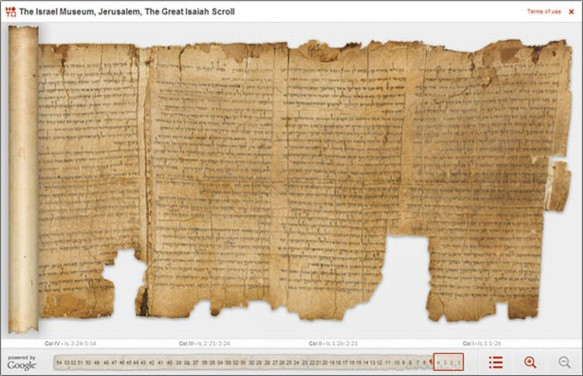Dead Sea Scrolls Online: Text Available Thanks to Google [VIDEO & LINKS]

The ancient texts of the Dead Sea Scrolls are online for the first time ever (with translation) thanks to a partnership between the Israel Museum in Jerusalem and Google.
Written between the first and third centuries B.C., the Dead Sea Scrolls are the oldest known biblical manuscripts in existence. They were hidden in 11 caves in the Judean desert along the shores of the Dead Sea in 68 B.C. as Roman armies approached. They remained hidden until 1947, when a Bedouin shepherd of the Ta'amra tribe threw a rock in a cave and realized that something was hidden inside.
The scrolls are considered by many to be the most significant archaeological find of the 20th century.
The Dead Sea Scrolls, made of parchment, papyrus and specially prepared animal skins, have been kept for decades in a secured vault in a Jerusalem building constructed specifically to house them. Access requires at least three different keys, a magnetic card and a secret code.
Several of the more complete scrolls have appeared on exhibit at the Israel Museum since 1965.
Mostly written in Hebrew (though some are in Aramaic or Greek), the scrolls provide critical insights into the life and religion in ancient Jerusalem, including the foundations of Christianity. As well as containing the oldest copies of many biblical texts, they also include many secular writings relating to life in the first and second centuries A.D.
They are really foundation stones to modern Western thought in the Judeo-Christian world in the same way that the 'Mona Lisa' was to development of art, James Snyder, director of the Israel Museum, told LiveScience. If you think of certain phrases that we all know, such as 'turning swords to plowshares,' meaning 'to not go to war anymore,' that comes from the Book of Isaiah, which we have in the Dead Sea Scrolls.
And 2000 years later, thanks to Google technology, the documents are online.
As the new year approaches on the Hebrew calendar, anyone can view, read and interact with five digitized Dead Sea Scrolls. These are the most complete of the eight that the Israel Museum has in its possession, and include the Great Isaiah Scroll (the only complete ancient copy of any biblical book in existence), and the Temple Scroll (the thinnest parchment scroll ever found among the hundreds of Dead Sea Scrolls).
Noted photographer of antiquities Ardon Bar-Hama used ultraviolet-protected flash tubes to light the scrolls for 1/4000th of a second. This exposure time, which is considerably shorter than a conventional camera flash, was used to protect the fragile scrolls from damage.
The ultra-high resolution photos include up to 1,200 megapixels in detail. That's nearly 200 times more than your average consumer digital camera and, as such, the minutest details of the scrolls can be seen.
Amazingly, the whole process took just six months, according to Snyder.
The high resolution photographs can be magnified and explored online by column, chapter and voice from Hebrew. If you click directly on the Hebrew text, you can get an English translation. While there, you can also leave a comment for others to see.
Furthermore, you can plow through the text via Web search. When you search for a phrase from the scroll, a link to that text within the scroll viewers on the Dead Sea Scrolls collection site should surface in your results.
The partnership between Google and The Israel Museum in Jerusalem is part of a larger effort to bring important cultural and historical collections to the world via the Internet.
Google has worked on similar projects in the past including the Yad Vashem Holocaust photo collection and the Google Art Project.
The Dead Sea Scrolls have become very popular in their first days online. The term Dead Sea Scrolls is one of the top trending searches on Google.
Have a look through the documents yourself using the links below.
The scrolls available for viewing online are:
The Commentary of Habakkuk Scroll
© Copyright IBTimes 2024. All rights reserved.






















